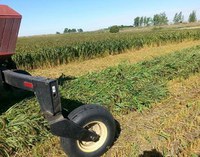Warm-season Annuals May Be Forage Option
(Click the image below to view a high-resolution image that can be downloaded)
Much of North Dakota remains dry, and forage for livestock still is a huge concern.
“Spotty showers and storms have given some localities some needed moisture, while much of western and north-central North Dakota remains critically dry,” says John Dhuyvetter, North Dakota State University Extension livestock systems specialist at the North Central Research Extension Center near Minot. “Options remain for planting some summer annual forage crops where moisture is adequate for emergence or rain may still come.”
Good choices for warm-season plantings include hay millets, forage sorghum and sudangrass hybrids, he notes.
Fine-seeded hay millets are economical to plant at about 15 pounds of seed per acre, but they must be seeded shallowly, at 1/2 to 3/4 inch deep, and likely will require precipitation for germination and emergence.
The millets are finer-stemmed than forage sorghums, allowing for faster dry-down and easier haying. If cut at early heading, forage quality and palatability generally are good, with crude protein at 8-plus percent and total digestible nutrients at about 58 percent.
A planting risk is that weeds, including foxtails, will emerge simultaneously, resulting in competition and stunted stands of millet.
While not a choice for horses, sorghum and sudangrass hybrids have the advantages of a larger seed, greater competitiveness and deeper rooting, Dhuyvetter says. These hybrids may be sown up to 1.25 inches deep.
Recommended seeding rates when drilled in solid stands are 20 to 30 pounds per acre. With moisture, fertility and warm temperatures, they have robust growth and high yield potential.
Haying should be timed at head emergence or when the plants are 4 to 5 feet tall. As a coarse-stemmed, leafy plant, these hybrids are difficult to cure to acceptable haying moisture without low humidity and intense sun. Cut these crops with a mower conditioner that crushes and crimps the stalks.
Dhuyvetter suggests that considering the potential for continued drought, plant stress and possible nitrate accumulation, producers should apply modest rates of nitrogen unless soil tests indicate adequate fertility. He recommends 50 to 60 pounds of nitrogen and 15 pounds of phosphorous.
He also advises testing forages with low production and poor plant development before feeding them to livestock.
Sorghum hybrids can be grazed, but preferably, producers should wait to turn cattle out onto the fields until the plants are 18 to 24 inches in height.
“Whether hayed or grazed, they are likely to regrow under favorable conditions for subsequent grazing,” Dhuyvetter says.
He adds that an alternative to haying or grazing a sorghum stand is to windrow it prior to frost and stockpile it for late-season swath grazing.
For more information on planting and harvesting warm-season forages, contact Dhuyvetter at 701-857-7682 or john.dhuyvetter@ndsu.edu, or visit https://tinyurl.com/NDSU-Warm-SeasonGrasses.
NDSU Agriculture Communication - June 6, 2018
| Source: | John Dhuyvetter, 701-857-7682, john.dhuyvetter@ndsu.edu |
|---|---|
| Editor: | Ellen Crawford, 701-231-5391, ellen.crawford@ndsu.edu |


